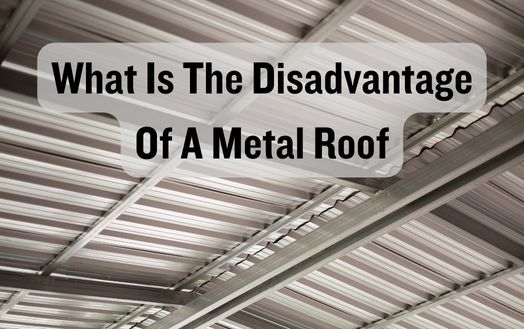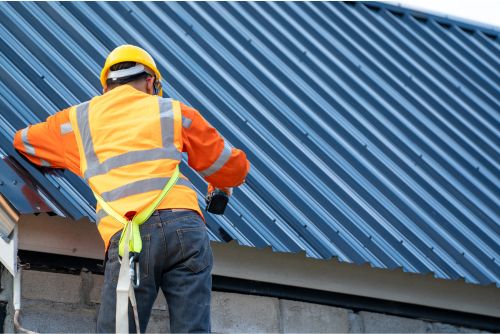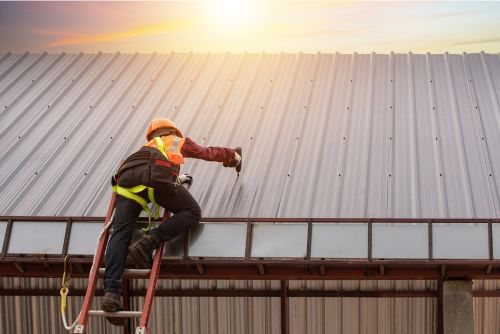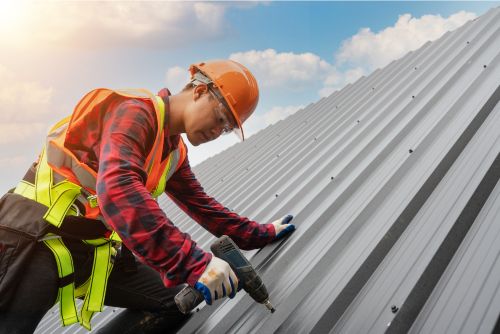
As I was sitting in my living room, enjoying the sound of rain gently tapping against the window, I couldn’t help but wonder about the disadvantages of having a metal roof. Sure, it may have its benefits such as durability and energy efficiency, but there must be some drawbacks to consider as well.
Little did I know, the world of metal roofing is not without its downsides, and in this discussion, we will explore some of the key disadvantages that you might want to keep in mind before making a decision.
So, let’s dive in and uncover what is the disadvantage of a metal roof.
Metal roof noise is especially disruptive during heavy rain or hail storms. Metal roofs are durable and long-lasting, but they have drawbacks that may not appeal to everyone. One drawback is increased noise during heavy rain or hailstorms. For those who prefer a quieter home, raindrops hitting the metal surface can be loud and unsettling.
Another consideration when choosing a metal roof is the upfront cost. Metal roofs are more expensive to install. Mostly due to higher material and installation costs. In the long run, metal roofs’ durability and low maintenance can offset their higher upfront costs.
Metal roofs dent easily, especially during hailstorms. Metal roofs can withstand harsh weather, but large hailstones can dent them and compromise their integrity. Before choosing a metal roof, consider your climate and weather patterns. Frequent hailstorms may cause dents.

The cost of a metal roof must be considered. Metal roofs have many benefits, but homeowners worry about the high upfront cost.
Metal roofs cost more than asphalt shingles or clay tiles. Material and installation costs can be high. Remember that a metal roof’s long-term benefits and savings can more than offset the initial investment.
The quality and durability of metal roof materials drive up the upfront cost. Metal roofs are weatherproof and low-maintenance, lasting decades. This longevity means homeowners won’t need to replace their roof as often as with other materials, saving money over time. Energy-efficient metal roofs reflect heat and lower summer cooling costs. Big utility bill savings from energy efficiency can offset the roof’s initial cost.
Metal roofs may seem expensive at first, but they offer long-term savings. A metal roof gives homeowners energy efficiency, lower maintenance costs, and peace of mind from a durable roofing system.
Metal roof installation requires skilled workers and attention to detail. Some homeowners dislike metal roof installation because it’s complicated and time-consuming. It provides durability, energy efficiency, and long-term cost savings when done correctly.
Installing metal roofing requires several steps. First, remove the old roofing and inspect the roof deck for damage. This step solidifies the metal roof foundation.
Next, metal panels are measured, cut, and shaped to fit the roof. Specialized fasteners secure the panels to the roof deck. Sealing edges and seams prevents water leakage.
A successful metal roof installation requires a professional roofing contractor. They know how to handle the process’s complexities. A skilled contractor will properly install the panels, preventing leaks and ventilation issues. They’ll also know local building codes for safety.
Despite their higher upfront cost, metal roofs have long-term benefits. Compared to traditional roofing materials, metal roofs last longer and require fewer repairs. They’re also more resistant to high winds and snow. Energy-efficient metal roofs reflect heat and lower summer cooling costs.

A metal roof needs regular maintenance to last and perform. Although metal roofs are durable, neglecting maintenance can cause many problems.
Poor maintenance can cause damage, a major drawback. Leaks, rust, and corrosion can damage a metal roof and shorten its lifespan if not maintained. To avoid these issues, maintain your metal roof regularly. Check for loose screws, flashing, and worn sealants on the roof. Debris, dirt, and leaves on the roof can trap moisture and cause rust, so regular cleaning is necessary.
Metal roofs are expensive to repair and maintain. Metal roofs are low-maintenance but expensive to repair or replace. If the damage is ignored for a long time, it may require more extensive repairs. Thus, issues must be addressed immediately to avoid further damage and costs.
A professional roofing contractor should perform regular maintenance and inspections to prolong the life of your metal roof. They know how to spot problems and fix them quickly. They can also advise on metal roof maintenance to extend its lifespan.
When it comes to metal roof color options, they may be limited compared to other roofing materials. While metal roofs are durable and energy-efficient, their color options may be limited. This can be a drawback for those who value home aesthetics and want a variety of colors. Consider these sub-lists for metal roofs’ limited color options:
Alternative roofing materials like asphalt shingles or clay tiles may offer more color options for innovators. These materials offer many color options, allowing homeowners to create a striking roof that matches their design.
Despite the limited color options, metal roofs’ longevity, energy efficiency, and environmental sustainability are important. While aesthetics are important, this roofing material’s other benefits must be considered. A holistic assessment of your needs and priorities should determine your roofing material.

Dents and scratches can damage metal roofs. Metal roofs are durable and energy-efficient, but they have drawbacks. Denting and scratching metal roofs is the topic of this article.
Metal roofs are more dent-prone than others due to their composition. Dents can result from hailstorms, falling branches, or roof walking. Dents can damage the roof’s appearance and structure. Also, debris and maintenance can scratch metal roofs. Untreated scratches can cause rust and corrosion and detract from aesthetics.
However, metal roof technology has improved these issues. Manufacturers are adding coatings and finishes to metal roofs to prevent dents and scratches. These coatings protect and strengthen the roof.
Additionally, regular maintenance and prompt dent and scratch repair can extend the life of a metal roof. Homeowners can prevent water leaks and roof damage by fixing these issues quickly.
Metal roofs expand and contract with temperatures, which can cause problems. Since steel expands and contracts more than other metals, steel roofing is especially affected. Knowing what is the disadvantage of a metal roof includes discovering about its expansion and contraction. Metal roof expansion and contraction can cause many problems, including:
Metal roofs’ expansion and contraction can be difficult. Innovative solutions are being developed to address these issues. Some manufacturers include expansion joints in metal roofing systems. These joints allow the roof to expand and contract without damaging the structure.
Insulation technology can also reduce metal roof expansion and contraction. Insulating the roof reduces temperature fluctuations, reducing leakage and noise.

After addressing expansion and contraction, metal roof heat retention is the next drawback. Improving energy efficiency is key to innovation. Unfortunately, metal roofs absorb and retain heat, increasing energy costs and discomfort in hot climates.
Heat is easily transferred from the sun’s rays to a building’s interior by metal roofs. While other roofing materials reflect sunlight, metal roofs retain heat longer due to their high thermal mass. This can raise indoor temperatures, especially in the summer.
Metal roofs’ heat retention can be harmful. First, it makes cooling systems work harder to maintain a comfortable temperature, raising energy bills. High air conditioning costs in hot climates can make this difficult. The excess heat can also make living or working spaces uncomfortable, reducing productivity and well-being.
There are several ways to reduce metal roof heat retention. A metal roof with reflective coatings or finishes can reduce heat absorption. Improved attic or ceiling insulation can reduce heat transfer into the building. Ventilation systems like ridge vents and attic fans can also reduce heat and improve airflow.
Leaks are metal roofs’ biggest concern. Metal roofs are durable, but improper installation or maintenance can cause leaks. Here are some reasons metal roofs may leak more than other roofing materials:
Regular inspections and maintenance reduce metal roof leaks. This includes checking for loose fasteners, sealing seams, and promptly addressing rust or corrosion.
Using high-quality materials and experienced professionals can also reduce leaks and extend the life of your metal roof.

Metal roofs can leak, making it hard to find experienced installers. Metal roofing installation requires expertise that not all roofers have. Installation delays, poor workmanship, and costly mistakes can result from a lack of experienced installers.
The unique properties of metal roofing cause this problem. Metal roofs must be installed using specific methods and tools, unlike asphalt shingles or clay tiles. Metalwork is complicated and requires precise measurements and attention to detail, requiring expertise. Due to its durability, energy efficiency, and modern aesthetic, metal roofing is becoming more popular. Due to their popularity, skilled installers are in short supply.
Finding reliable metal roof installers is essential to solving this problem. Find contractors with metal roof experience and customer references. Join metal roofing forums or community groups to talk to other homeowners who’ve installed it. These tips can help you find local installers with experience.
The roofing industry needs innovation to find experienced installers. As metal roof demand rises, roofing contractors must adapt and train their crews to install them. By encouraging industry education and collaboration, we can train skilled installers to meet the needs of homeowners seeking metal roof benefits.
Overall, metal roofs have several disadvantages including:
Despite these drawbacks, metal roofs are still a popular choice for many homeowners due to their:
It’s important to weigh the pros and cons before deciding if a metal roof is the right choice for your specific needs and circumstances. So now, we have finally answered the question: what is the disadvantage of a metal roof?
Metal roofs have environmental issues. Metal manufacturing is energy-intensive, which could increase energy consumption.
Without proper insulation, metal roofs can cause heat gain or loss, reducing energy efficiency. However, technology and insulation have reduced these issues, making metal roofs more eco-friendly.
The average lifespan of a metal roof is around 50 years. It’s a durable and long-lasting option that can withstand harsh weather conditions.
However, like any other roofing material, there are disadvantages to consider. For instance, metal roofs can be noisy during heavy rain or hailstorms. They also tend to be more expensive upfront compared to other roofing materials.
Metal roofs can be installed over shingle roofs. It saves time and money to remove the old roof with this innovative solution.
Installing the metal roof over the shingles adds insulation and leak protection. However, the existing roof must be in good condition to support the new metal roof. Metal roofs need regular inspections and maintenance to last.
I don’t think metal roofs are more lightning-prone than other materials. Although conductive, metal doesn’t attract lightning strikes more than other materials. Metal roofs can even dissipate lightning energy, reducing structural damage. The myth that metal roofs attract lightning is false.
Metal roof condensation hasn’t bothered me. It seems well-insulated and doesn’t need extra insulation. My metal roof is durable and energy-efficient, which I like. This sleek, modern piece adds innovation to my home.